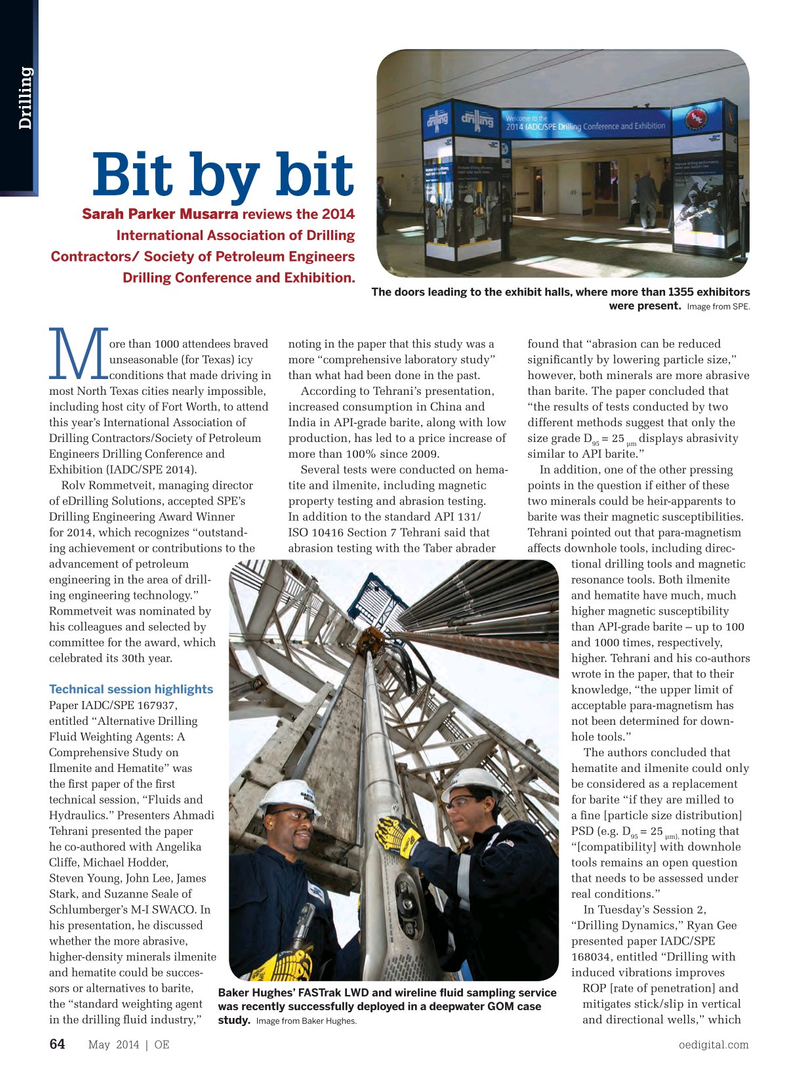
Page 62: of Offshore Engineer Magazine (May/Jun 2014)
Read this page in Pdf, Flash or Html5 edition of May/Jun 2014 Offshore Engineer Magazine
Drilling
Bit by bit
Sarah Parker Musarra reviews the 2014
International Association of Drilling
Contractors/ Society of Petroleum Engineers
Drilling Conference and Exhibition.
The doors leading to the exhibit halls, where more than 1355 exhibitors were present. Image from SPE.
ore than 1000 attendees braved noting in the paper that this study was a found that “abrasion can be reduced laboratory study” signifcantly by lowering particle size,” unseasonable (for Texas) icy more “comprehensive
M than what had been done however, both minerals are more abrasive conditions that made driving in in the past.
According to Tehrani’s presentation, than barite. The paper concluded that most North Texas cities nearly impossible, increased consumption in China and “the results of tests conducted by two including host city of Fort Worth, to attend
India in API-grade barite, along with low different methods suggest that only the this year’s International Association of production, has led to a price increase of size grade D = 25 displays abrasivity
Drilling Contractors/Society of Petroleum 95 µm more than 100% since 2009. similar to API barite.”
Engineers Drilling Conference and
Several tests were conducted on hema- In addition, one of the other pressing
Exhibition (IADC/SPE 2014).
Rolv Rommetveit, managing director tite and ilmenite, including magnetic points in the question if either of these of eDrilling Solutions, accepted SPE’s property testing and abrasion testing. two minerals could be heir-apparents to
Drilling Engineering Award Winner In addition to the standard API 131/ barite was their magnetic susceptibilities. for 2014, which recognizes “outstand- ISO 10416 Section 7 Tehrani said that Tehrani pointed out that para-magnetism ing achievement or contributions to the abrasion testing with the Taber abrader affects downhole tools, including direc- advancement of petroleum tional drilling tools and magnetic engineering in the area of drill- resonance tools. Both ilmenite ing engineering technology.” and hematite have much, much
Rommetveit was nominated by higher magnetic susceptibility his colleagues and selected by than API-grade barite – up to 100 committee for the award, which and 1000 times, respectively, celebrated its 30th year. higher. Tehrani and his co-authors wrote in the paper, that to their
Technical session highlights knowledge, “the upper limit of
Paper IADC/SPE 167937, acceptable para-magnetism has entitled “Alternative Drilling not been determined for down-
Fluid Weighting Agents: A hole tools.”
Comprehensive Study on
The authors concluded that
Ilmenite and Hematite” was hematite and ilmenite could only the frst paper of the frst be considered as a replacement technical session, “Fluids and for barite “if they are milled to
Hydraulics.” Presenters Ahmadi a fne [particle size distribution]
Tehrani presented the paper
PSD (e.g. D = 25 noting that 95 µm), “[compatibility] with downhole he co-authored with Angelika tools remains an open question
Cliffe, Michael Hodder, that needs to be assessed under
Steven Young, John Lee, James real conditions.”
Stark, and Suzanne Seale of
In Tuesday’s Session 2,
Schlumberger’s M-I SWACO. In “Drilling Dynamics,” Ryan Gee his presentation, he discussed presented paper IADC/SPE whether the more abrasive, 168034, entitled “Drilling with higher-density minerals ilmenite induced vibrations improves and hematite could be succes- sors or alternatives to barite,
ROP [rate of penetration] and
Baker Hughes’ FASTrak LWD and wireline fuid sampling service the “standard weighting agent mitigates stick/slip in vertical was recently successfully deployed in a deepwater GOM case in the drilling fuid industry,” and directional wells,” which study. Image from Baker Hughes.
May 2014 | OE oedigital.com 64 064_OE0514_D&C2_IADC.indd 64 4/18/14 8:20 PM

 61
61

 63
63